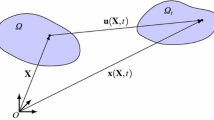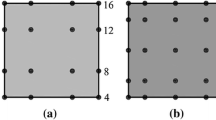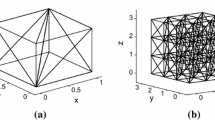Abstract
It is known that the reduction in the finite element space discretization error for elastodynamics problems is related to the reduction in numerical dispersion of finite elements. In the paper, we extend the modified integration rule technique for the mass and stiffness matrices to the dispersion reduction of linear finite elements for linear elastodynamics. The analytical study of numerical dispersion for the modified integration rule technique and for the averaged mass matrix technique is carried out in the 1-D, 2-D and 3-D cases for harmonic plane waves. In the general case of loading, the numerical study of the effectiveness of the dispersion reduction techniques includes the filtering technique (developed in our previous papers) that identifies and removes spurious high-frequency oscillations. 1-D, 2-D and 3-D impact problems for which all frequencies of the semi-discrete system are excited are solved with the standard approach and with the new dispersion reduction technique. Numerical results show that compared with the standard mass and stiffness matrices, the simple dispersion reduction techniques lead to a considerable decrease in the number of degrees of freedom and computation time at the same accuracy, especially for multi-dimensional problems. A simple quantitative estimation of the effectiveness of the finite element formulations with reduced numerical dispersion compared with the formulation based on the standard mass and stiffness matrices is suggested.
Similar content being viewed by others
References
Babuska I, Ihlenburg F, Strouboulis T, Gangaraj SK (1997) Posteriori error estimation for finite element solutions of Helmholtz’ equation—part ii: estimation of the pollution error. Int J Numer Methods Eng 40(21): 3883–3900
Babuska I, Strouboulis T, Gangaraj SK, Upadhyay CS (1997) Pollution error in the h-version of the finite element method and the local quality of the recovered derivatives. Comput Methods Appl Mech Eng 140(1–2): 1–37
Bathe KJ (1996) Finite element procedures. Prentice-Hall, Upper Saddle River
Cherukuri HP (2000) Dispersion analysis of numerical approximations to plane wave motions in an isotropic elastic solid. Comput Mech 25(4): 317–328
Dauksher W, Emery AF (2000) Solution of elastostatic and elastodynamic problems with chebyshev spectral finite elements. Comput Methods Appl Mech Eng 188(1): 217–233
Deraemaeker A, Babuska I, Bouillard P (1999) Dispersion and pollution of the fem solution for the Helmholtz equation in one, two and three dimensions. Int J Numer Methods Eng 46(4): 471–499
Gabriel D, Plesek J, Kolman R, Vales F (2010) Dispersion of elastic waves in the contact-impact problem of a long cylinder. J Comput Appl Math 234: 1930–1936
Guddati MN, Yue B (2004) Modified integration rules for reducing dispersion error in finite element method. Comput Methods Appl Mech Eng 193: 275–287
Hughes TJR (1987) The finite element method: linear static and dynamic finite element analysis. Prentice-Hall, Englewood Cliffs
Hulbert GM (1992) Discontinuity-capturing operators for elastodynamics. Comput Methods Appl Mech Eng 96(3): 409–426
Hulbert GM, Hughes TJR (1990) Space–time finite element methods for second-order hyperbolic equations. Comput Methods Appl Mech Eng 84(3): 327–348
Idesman A, Subramanian K, Schmidt M, Foley JR, Tu Y, Sierakowski RL (2010) Finite element simulation of wave propagation in an axisymmetric bar. J Sound Vib 329: 2851–2872
Idesman AV (2007) A new high-order accurate continuous Galerkin method for linear elastodynamics problems. Comput Mech 40: 261–279
Idesman AV (2007) Solution of linear elastodynamics problems with space-time finite elements on structured and unstructured meshes. Comput Methods Appl Mech Eng 196: 1787–1815
Idesman AV (2010) Accurate time integration of linear elastodynamics problems. Comput Methods Appl Mech Eng 1–29 (submitted)
Idesman AV, Samajder H, Aulisa E, Seshaiyer P (2009) Benchmark problems for wave propagation in elastic materials. Comput Mech 43(6): 797–814
Krenk S (2001) Dispersion-corrected explicit integration of the wave equation. Comput Methods Appl Mech Eng 191: 975–987
Marfurt KJ (1984) Accuracy of finite difference and finite element modeling of the scalar and elastic wave equation. Geophysics 49: 533–549
Mullen R, Belytschko T (1982) Dispersion analysis of finite element semidiscretizations of the two-dimensional wave equation. Int J Numer Methods Eng 18: 11–29
Nowacki W (1975) Dynamic problems of thermoelasticity. Springer, Berlin
Seriani G, Oliveira SP (2007) Optimal blended spectral-element operators for acoustic wave modeling. Geophysics 72(5): 95–106
Seriani G, Oliveira SP (2008) Dispersion analysis of spectral element methods for elastic wave propagation. Wave Motion 45(6): 729–744
Yue B, Guddati MN (2005) Dispersion-reducing finite elements for transient acoustics. J Acoust Soc Am 118(4): 2132–2141
Zienkiewicz OC, Taylor RL (2000) The finite element method. Butterworth-Heinemann, Oxford
Zyserman FI, Gauzellino PM (2005) Dispersion analysis of a nonconforming finite element method for the three-dimensional scalar and elastic wave equations. Finite Elem Anal Des 41(13): 1309–1326
Author information
Authors and Affiliations
Corresponding author
Rights and permissions
About this article
Cite this article
Idesman, A.V., Schmidt, M. & Foley, J.R. Accurate finite element modeling of linear elastodynamics problems with the reduced dispersion error. Comput Mech 47, 555–572 (2011). https://doi.org/10.1007/s00466-010-0564-3
Received:
Accepted:
Published:
Issue Date:
DOI: https://doi.org/10.1007/s00466-010-0564-3




